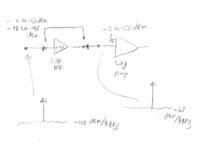Fábio Cunha
Newbie level 3
Hello all.
I'm designing a Radio-Frequency Power Detector. This circuit will detect any signals ranging from 50MHz to 8GHz
I found some IC's that say they do the job:
- 50 MHz to 4 GHz 40 dB Logarithmic Power Detector for CDMA and WCDMA (LMH2100);
- 50 MHz to 8 GHz Logarithmic RMS Power Detector with 45 dB dynamic range (LMH2110).
This IC's basic implementations is described on the image below:
https://imgur.com/Js3xLjo
So, my doubt is:
- Which one of this should i choose?
- Do i need some bandpass filter before my RFinput? Will i need an Amplifier?
The datasheets don't explain this things...
And i couldn't find application notes from Ti, or Linear...
Sorry for my English.
Thank You. I finally had the "balls" to write for some guidance. I already read many topics here.
- - - Updated - - -
Edit:
All the applications that i Find are made for measurements on the Transmitting side.
I would like ti know if i could the the "reverse" and apply it to the Receiving side:
- (Signal Received by the antenna, the signal is amplified with a Low-Noise Amplifier and then, the result is the Input of my Power detector.)
I'm designing a Radio-Frequency Power Detector. This circuit will detect any signals ranging from 50MHz to 8GHz
I found some IC's that say they do the job:
- 50 MHz to 4 GHz 40 dB Logarithmic Power Detector for CDMA and WCDMA (LMH2100);
- 50 MHz to 8 GHz Logarithmic RMS Power Detector with 45 dB dynamic range (LMH2110).
This IC's basic implementations is described on the image below:
https://imgur.com/Js3xLjo
So, my doubt is:
- Which one of this should i choose?
- Do i need some bandpass filter before my RFinput? Will i need an Amplifier?
The datasheets don't explain this things...
And i couldn't find application notes from Ti, or Linear...
Sorry for my English.
Thank You. I finally had the "balls" to write for some guidance. I already read many topics here.
- - - Updated - - -
Edit:
All the applications that i Find are made for measurements on the Transmitting side.
I would like ti know if i could the the "reverse" and apply it to the Receiving side:
- (Signal Received by the antenna, the signal is amplified with a Low-Noise Amplifier and then, the result is the Input of my Power detector.)
